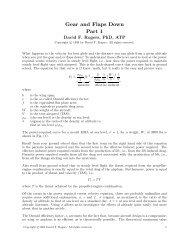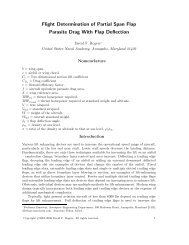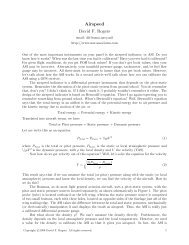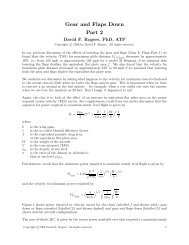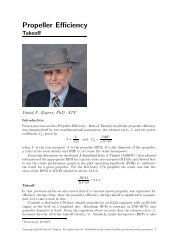Efficiently Wasting Fuel - NAR Associates
Efficiently Wasting Fuel - NAR Associates
Efficiently Wasting Fuel - NAR Associates
You also want an ePaper? Increase the reach of your titles
YUMPU automatically turns print PDFs into web optimized ePapers that Google loves.
Carson asked the question “What is the unit cost in increased fuel consumption for<br />
each unit increase in speed” His results showed that the best rate of return for increased<br />
fuel consumption as a result of increased cruise speed was<br />
V cruise =(3) 1/4 V L/D max<br />
=1.32V L/D max<br />
while the increase in fuel consumption was 2/ √ 3=1.16, i.e., a 32% increase in cruise TAS<br />
for just a 16% increase in fuel consumption. The increase in cruise TAS resulted in a 52%<br />
increase in power required and a 24% decrease in the flight time. From this one can also<br />
conclude that the value of a 24% decrease in flight time is worth the cost of an additional<br />
16% for fuel. V cruise has become known as the Carson cruise, e.g., CAFE (Comparative<br />
Aircraft Flight Efficiency) calculates the Carson cruise speed when evaluating an aircraft.<br />
Table 1 True Airspeeds (kts)<br />
Altitude V L/D max<br />
V cruise 75% 65% 55%<br />
feet<br />
BHP BHP BHP<br />
0 105 139 163 154 143<br />
2000 108 143 166 157 146<br />
4000 112 147 169 159 148<br />
6000 115 152 172 162 149<br />
8000 119 156 171* 164* 151<br />
10000 122 161 169* 161* 150*<br />
12000 126 166 166* 158* 146*<br />
14000 131 172 163* 158* 141*<br />
From a practical viewpoint, how do we apply the Carson cruise results to every day<br />
operation First, as shown in Table 1, remember that the true airspeed for L/D max increases<br />
with increasing altitude. Hence, the Carson cruise true airspeed also increases with<br />
increasing altitude. Also shown in Table 1 are the true airspeeds for 75% (2500 RPM),<br />
65% (2300 RPM) and 55% (2100 RPM) BHP (brake horsepower) taken from the POH for<br />
a 285 BHP model E33A Bonanza for a weight of 3100 lbs. The asterisks indicate operation<br />
at full throttle and the indicated fixed RPM, i.e., at less than the indicated percentage of<br />
BHP. Comparing the V cruise true airspeeds and those for 75% BHP, we see that at 12,000<br />
feet the true airspeeds are equal at 166 kts. Similarly, for 65% BHP the true airspeeds are<br />
equal at 10,000 feet pressure altitude at 161 kts. At 55% BHP, note that the true airspeeds<br />
do not match at any altitude. Thus, at 55% BHP (2100 RPM) flight at the Carson cruise<br />
true airspeed is not possible at any altitude. This is not surprising. Note that for both<br />
75% BHP (2500 RPM) and 65% BHP (2300 RPM) operation is at full throttle and a fixed<br />
RPM, hence at less than the indicated percentage of brake horsepower. Carefully checking<br />
the altitude performance curves from the POH shows that operation at both 2500 RPM<br />
and 2300 RPM at full throttle at the required altitudes yields about 59% BHP.<br />
Normally aspirated reciprocating engine propeller combinations have a critical altitude<br />
at which they can maintain a specified percentage of sea level BHP. This critical altitude<br />
is sometimes called the knee of the altitude-true airspeed curve. For a given percentage of<br />
sea level BHP, the knee represents the most efficient operating condition, i.e., the highest<br />
TAS for a given percentage of sea level BHP and hence fuel expended. As an example, for<br />
a model E33A at a weight of 3100 pounds at 65% BHP on a standard day the knee of the<br />
curve occurs at approximately 7600 feet pressure altitude and yields a TAS of 164 kts.<br />
By comparing the Carson cruise TAS, V cruise , and the knee velocity, V knee , as a function<br />
of percent BHP using the two curves in the lower plot of Figure 1, we see that the two curves<br />
cross at approximately 58.6% BHP, yielding a TAS of approximately 157 kts (180 mph).<br />
Copyright c○2003 David F. Rogers. All rights reserved. 3



